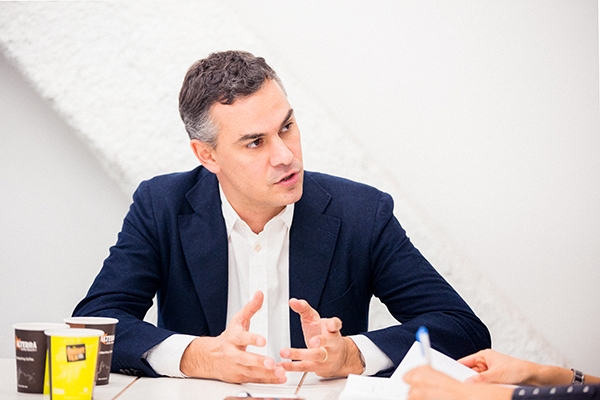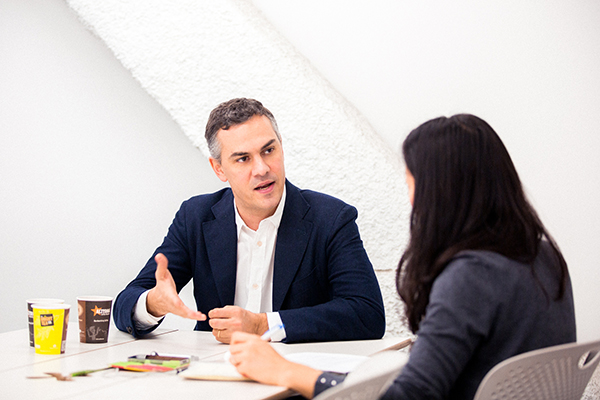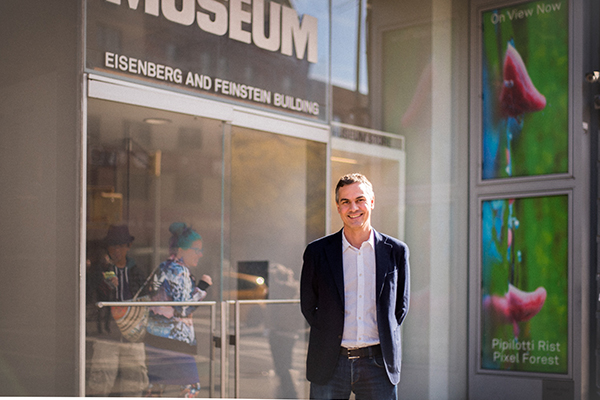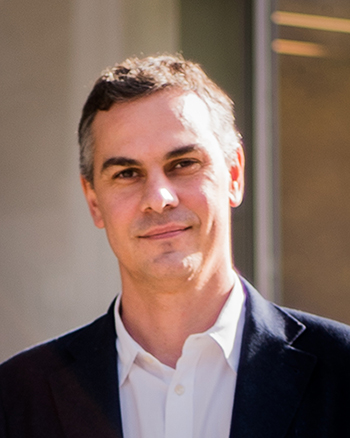International exhibitions: Massimiliano Gioni
Massimiliano Gioni
(Edlis Neeson Artistic Director, New Museum of Contemporary Art)
Massimiliano Gioni, a native of Italy, served as the general director of the 55th Venice Biennale International Art Exhibition (2013). Gioni drew much attention for being the youngest curator to be selected for the biennale, as well as for his decision to present outsider art. While based in New York in the United States, Gioni also curates large international exhibitions held in Asia and the Middle East. What does he think about when planning exhibitions in cultural spheres that differ from his homeland and how does he go about it? We interviewed Gioni in New York about his encounters with Japan, what he expects of exhibition visitors, and the future of international exhibitions.

Involvement with Japan
In addition to going to Japan at the invitation of the Japan Foundation to attend the 1st Yokohama Triennale held in 2001, I have also visited Japan several times prior to that in exchanges with CCA Kitakyushu. I went there again in 2010, to do research for the Gwangju Biennale. That trip was also thanks to the Japan Foundation. From afar there is this image of Japanese art and the Japanese art system as being monolithic, so it was very refreshing when I actually went there and was able to understand much more of the texture, not to mention being able to meet many artists. On that trip, I was particularly impressed by Shinro Ohtake. I saw an illustrated book from his solo exhibition at the Museum of Contemporary Art Tokyo and I was puzzled by the thickness of it, but then I was able to actually meet him and it made much more sense to me. Coming across works associated with Jikken Kobo was also particularly important. Adventure of the Eyes of Mr. W.S., a Test Pilot, a video piece by Katsuhiro Yamaguchi, is very inspiring and it came to have an important meaning in the Gwangju Biennial, while the collective work Ginrin (Silver Wheel) returned in many other exhibitions of mine. Moreover, I went to see Takashi Murakami in Japan prior to his large-scale exhibition Murakami-Ego I curated (Qatar Museum, 2012).

Gioni talking about his personal involvement with Japan
Applying experiences from Gwangju Biennale (2010) to the Venice Biennale International Art Exhibition (2013)
More than half a million people visited the 8th Gwangju Biennale (2010) in 66 days. It was my first experience of curating an exhibition in Asia. Naturally, I was expected to tailor the exhibition to the visitors. In Europe and the United States, when I look at the people who come to openings, I can immediately distinguish between who the collectors are, who the students are, and so on from the way they dress and behave, but not so in South Korea or Japan. I was aware that most of the visitors would be from Asia, which put a lot of pressure on me.
At Gwangju I had to rethink a lot of the formats and configurations from my previous experiences. The frameworks I had seen up to that point no longer appeared as clear. Furthermore, having to address half a million people was a completely different responsibility for me compared to the past. Specifically, it forced me to understand how to deliver messages that could more easily be understood by diverse visitors. I think of a show as a place of learning, of discovery, and of teaching. And if I learn a lot, the audience learns a lot too. Obviously, I am interested in learning through the senses and through pleasure. However, largely because of the fact that I was a stranger to Asian culture and what is considered to be mainstream in it, I had to reconsider how I think about visitors and how I address them.
As a personal experience the Gwangju Biennale was an important turning point. I was forced to learn certain things and engage with language differences, which taught me a lot, including how important it is to direct with clarity, and about streamlining information and providing it clearly.
I think I was able to apply my experiences from Gwangju to the Venice Biennale International Art Exhibition (2013). I think in Venice the big shock for many people was my decision to present work by artists who are not typically shown in the traditional contemporary art scene, including non-professional artists and outsider artists. Some people will probably remember it as the "outsider artist biennale." I also made a point of presenting a lot of works that were not for sale or that existed beyond the art market, and the show opened with Carl Gustav Jung's famous The Red Book. You cannot buy The Red Book, and I had to make a huge effort to get it there. To me, showing that book was an accomplishment in itself, as it was such a complicated loan. Just as Jung had nothing to do with who owns it or who buys it, my Venice Biennale had many works that were on loan from museums. The Encyclopedic Palace of the World, created by Marino Auriti, the piece that also gave the title The Encyclopedic Palace to the show, was on loan from the American Folk Art Museum. I wanted to have enough of those examples to remind the audience that they did not come here to make purchases.
I do not know if this Biennale succeeded or not, but that was how I had chosen to position the exhibition and it came with significant risks. If I did not take that risk it would have been a terrible exhibition. Even when you are in charge of the Venice Biennale, you should also keep your ego a little bit in check and know that you actually achieve more if you keep working rather than if you just think of yourself as a big shot.
International art exhibitions and art fairs
In recent years biennales and triennales have been held all over the world. With the sudden rise of these kinds of art events, many art professionals, art lovers, and city administrators are probably also paying attention to where this is headed.
In my own case, it is very interesting because my own growth coincided with this phenomenon. I remember being interested in art at a time when you did not hear the word "curator" so much. I went to my first Venice Biennale in 1993 when I was 19. Following that, the number of biennales suddenly began to increase and we began to see an increasing professionalization of curatorial roles. I have no intention of saying dismissive things about biennales. You could say they have been an important formative element in my life by broadening my view to think of art globally and introducing me to the differences among many cultures. So I think there is also a lot of good in biennales. When they are not being used as flagbearers for a kind of internationalism, they are still quite healthy. The way certain biennales helped redefine the hegemonic structure of the West - the approaches taken in São Paulo, Gwangju, and Yokohama, for example - is also particularly interesting. The Havana Biennale and other biennales were also events that said "Look, I am also here, you have to come to terms with me."

Gioni talking about international art exhibitions held around the world
Of course, I am aware of a certain biennial tendency by which the artists and the art tend to be "parachuted" into a region without any attachment to the local context whatsoever. On the other hand, you also see some biennales that are capable of redesigning the borders and the priorities of the art world. So I think you cannot blame biennales in general, but I think you can certainly partially criticize some. The rapid growth of biennales in regions worldwide at the moment is something that young curators should keep in mind.
In a sense the word "biennale" itself has now become empty of any special meaning. As the word suggests, biennales only happen every two years. This can also be perceived as an opportunity to come up with a format completely without restriction.
I think what we have seen with biennales since around 2003 is that city administrations realized that another successful model existed in the form of the art fair. If we criticize the proliferation of biennales worldwide, surely the focus will be shifted to more art fairs. We have seen as many art fairs in the last decade as biennales. A fair's agenda is to sell works of art. For dealers and collectors, a fair is an entirely commercial event. Biennales attract criticism for their running costs, whereas with art fairs, basically 50% of the costs can be recovered from the participating galleries. In fact, art fairs typically make money. Fairs are also glamorous social events that can attract over 60,000 viewers in three days. But how many people who go to art fairs are aware that the art is being displayed for the purpose of being sold? No matter how much of an educational element you put into an art fair it is still an art fair, and there is a huge difference with a biennale. So I do not want to talk negatively about biennales, because then the solution seems to be more art fairs, which makes me both nervous and depressed.

At the New Museum
Interviewer: Tomomi Tanikawa, The Japan Foundation, New York
Text: Kae Shigeno
Photos: Ayumi Sakamoto
Massimiliano Gioni
Massimiliano Gioni is the Edlis Neeson Artistic Director of the New Museum in New York and director of the Nicola Trussardi Foundation in Milan. He was the director of the Venice Biennale in 2013 and has internationally organized many large-scale exhibitions, including Manifesta 5 (2004), the 4th Berlin Biennale (2006), and the 10th Gwangju Biennale (2010).
Related Articles
Back Issues
- 2025.6. 9 Creating a World Tog…
- 2024.10.25 My Life in Japan, Li…
- 2024.5.24 The 50th Japan Found…
- 2024.5.24 The 50th Japan Found…
- 2024.5. 2 People-to-People Exc…
- 2024.5. 2 People-to-People Exc…
- 2023.12. 7 Movie Theaters aroun…
- 2023.6.16 The 49th Japan Found…
- 2023.4.24 The 49th Japan Found…
- 2022.12.27 Living Together with…


